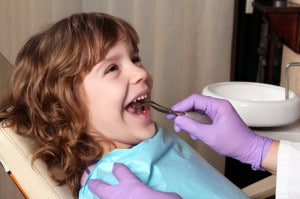Should I Be Concerned About BPA in My Child’s Mouth?
Is there BPA in my child’s fillings?
BPA (Bisphenol A) has been in the news quite often recently. Large doses used in experiments showed it had an adverse effect on brain and sexual development. Environmental groups asked the FDA to ban BPA from use in the United States. It has been blamed for a variety of ills, whether documented by science or not. Is there BPA in my child’s fillings? If so, what can I do about it?
It’s important to note that BPA is not used as an additive to sealants and composites. Composite resins are made from a variety of monomers (a single molecule that can be bonded to other molecules). BPA is used in the manufacturing of some of the raw ingredients which are then used to make the resins (such as Bis-DMA). The residual BPA can be present in trace amounts, representing those molecules which weren’t converted into other monomers. Bis-DMA can also be broken down by saliva, especially in its pre-hardened state, releasing minute amounts of BPA.
Here are the most up-to-date answers to commonly asked questions:
What is BPA?
BPA, or Bisphenol A, is a carbon-based synthetic compound used in polycarbonate and epoxy resins. It makes plastics extremely tough and far less likely to crack or break. It has high heat resistance. These attributes make it desirable for use in the raw materials used to manufacture dental sealants and composite material.
How much BPA is safe?
In a study by Pacific Northwest National Laboratory, men and women were given a diet loaded with BPA. Interestingly, very little of it actually made it into the bloodstream because the human body is very good at rendering chemicals such as BPA inactive. The resulting measurements in blood and tissue were too small to measure in the subjects tested.
Is BPA released from dental sealants or composites?
According to the American Academy of Pediatric Dentistry (AAPD), a minute amount of BPA may be released into saliva for up to three hours after resin is placed. A study by the FDA concluded that there was no detectable concentration in the bloodstream after such a dental procedure. Both agencies determined that the exposure was well below the threshold for any risk.
What can your child’s Pediatric Dentist do to minimize the exposure?
Here are a few precautionary application techniques recommended by the AAPD and the ADA (American Dental Association) to minimize exposure:
- Using a longer curing time with lower intensity lights, which results in less release of the BPA
- Rinsing the mouth for 30 seconds following application of sealers with water or saline solution
- Rubbing the sealant using a mild abrasive on a cotton applicator or prophy cup
- Temporarily blocking the area with a rubber dental dam preventing leaching of the BPA to saliva

Are there safer compounds being tested?
BPA has been widely and extensively tested. There are other compounds being used as alternatives, but the concern is that they have not been adequately tested and may, in fact, pose a greater danger than BPA. A study at the University of Austin, Texas, by professor of neurobiology George Bittner showed that some of the BPA-free products released synthetic estrogen compounds even more potent than BPA. According to that study, US Law deems chemicals safe unless they are proven otherwise. The BPA-free compounds developed in response to the current scare do not require testing and may pose a far greater health risk.
How can I decide what type of sealant or composite filling material is best for my child?
Your child’s Pediatric Dentist will conduct a thorough examination and make recommendations based on many factors. Sealants are only recommended under certain circumstances, and are excellent for filling in pits and grooves that might otherwise invite bacteria to enter. The filling material used is based on the location and size of cavity your child has because each type offers the best protection for specific issues. You should feel comfortable asking your child’s Pediatric Dentist why she recommends any procedure or material.
Know that it is far more dangerous to allow your child to have untreated cavities, which can result in permanent tooth loss, damage to the jaw, or even serious and painful abscesses. Today’s dentistry is more pain-free and less risky than ever before in history – and your child can have a lifetime of great oral health and a beautiful smile as a result.













